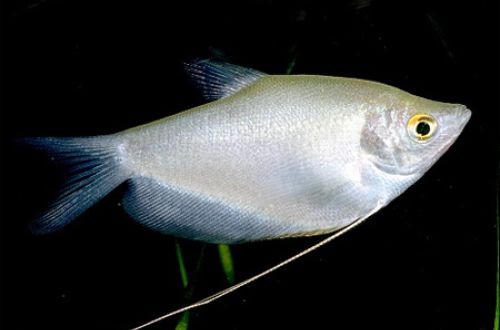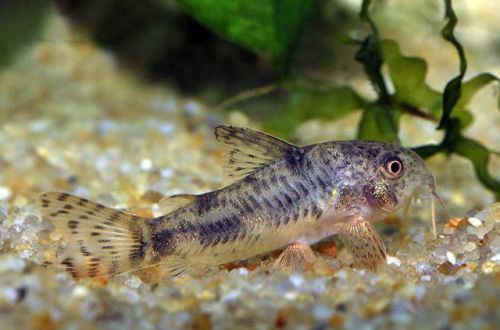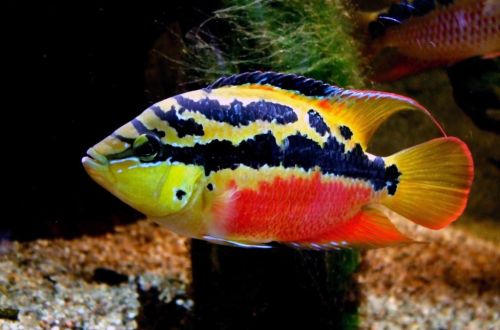
Lunar Gourami
The moon gourami, scientific name Trichopodus microlepis, belongs to the Osphronemidae family. Magnificent in its beauty, the fish, although it does not differ in an abundance of colors, the ability of its scales to reflect even weak light, creating a glowing effect of a white-moon color, compares favorably with other Gourami.

In Thailand, this species is called Pla Kadi Nang, while the rest of the Gourami are simply called Pla Kadim, and the word “Nang” means “woman.” This confusion arose due to the fact that the Moon Gourami was considered a female Blue Gourami.
Contents
Habitat
The first specimens were found in Southeast Asia in Vietnam, Cambodia and Thailand. However, the species has now been bred outside of its natural range, and wild populations of the Moon Gourami can be found as far away as South America. In nature, these fish are found on the plains in swampy reservoirs, swamps, lakes, in the floodplain of the Mekong River. They prefer regions of shallow depth with standing water along the overgrown coast. They feed on zooplankton, crustaceans and aquatic insects.
They have an unusual feature of catching small insects above the surface of the water; for this, the fish sprays a jet of water with a sharp contraction of the oral cavity and knocks the prey into the water.
Description
The fish has a compressed, elongated body covered with fine, highly reflective scales, giving a glowing effect even in very low light. It has very long pectoral filamentous fins, longer than any other gourami species. The color of the body is silvery, with age a greenish tint appears on the back, the iris of the eyes can become red or orange, in males a similar color extends to the fins, in females, on the contrary, they are either colorless or light yellow.
Food
At home, they accept any food intended for aquarium fish. On sale there are special feeds for Gourami, which have all the necessary vitamins and minerals. You can diversify the diet with live food: bloodworms, tubifex, mosquito larvae, etc., will not refuse herbal supplements in the form of small pieces of spinach, lettuce. Feed once or twice a day depending on the diet. If live food is present in the food, then once is enough.
Maintenance and care
For successful keeping, you will need a spacious tank of 150 liters for a pair of fish. Of the equipment, the presence of a filter, an aerator, a heater and a lighting system is mandatory. Choose a filter taking into account the fact that it must be productive, but at the same time create a slight movement of water. Since the fish prefer stagnant water, the excess current will provoke a stressful situation. Although the Moon Gourami is able to live in oxygen-depleted water, creating such conditions in an aquarium is not recommended. Aeration should be constant, preferably the use of small sprayers. If the fish constantly stays near the surface and swallows air, then the level of oxygen in the water is low, this is due to both poor aeration and a large amount of organic waste. The decomposition of products is carried out with the absorption of oxygen. Regular water renewal of 25% weekly is welcome.
In the design, a balance should be achieved between free areas for swimming and dense thickets of plants with shelters in the form of grottoes and snags. Fish are prone to plant damage, so use hard-leaved large plantings with a strong root system or artificial plants. However, live plants are still preferred, being an important link in the biological system of the aquarium. A dark substrate will emphasize the color of the fish, there are no special requirements for the size of the soil particles.
Social behavior
Gourami are able to successfully live both in pairs and in groups. It is worth considering that a community of 3 or more fish requires a large tank with enough hiding places, since adult males show territorial behavior, and in a small aquarium, a weaker individual will be subjected to constant aggression. Females are more tolerant, the optimal ratio is one male to several females.
Choose peaceful, calm and large species as neighbors; small fish can become an object of persecution. Very active fish will disturb Gourami, provoke aggression. Excellent candidates are catfish, some types of gourami.
Sexual differences
Males are slimmer and more graceful than females, they are distinguished by orange-colored fins, which turn red during spawning. In addition, the dorsal and anal fins are pointed.
Breeding / breeding
Breeding requires certain skills, for beginner aquarists it can be an overwhelming task. If the aquarium contains a male/female pair without other neighbors, then spawning can take place in the main aquarium, otherwise the pair should be transplanted into a separate tank, where it will be necessary to recreate similar habitat conditions.
The stimulus for spawning is increased feeding on meat products, a decrease in the water level to 20 cm, and a decrease in hardness to 2–5 dGH. The female will gradually begin to fill with caviar, which will swell greatly, at this time the male’s fins will turn red. He will start building a nest of plant bits and bubbles that can be up to 20 cm in diameter. At the end of construction, the mating ritual begins, the male attracts the female and invites her to his nest.
Spawning lasts about two hours, during which time the female lays up to 2000 eggs, which are immediately fertilized. The male remains to guard the clutch, the female moves away and no longer approaches the nest.
The fry appear on the second day, and after another two days they swim freely in the aquarium. During this time, they must be isolated from their parents, who may eat them. Feed microfeed, ciliates, daphnia.
Fish diseases
In a balanced aquarium, health problems do not arise, however, deterioration of conditions provokes primarily bacterial infections, digestive problems, and constipation. Read more about symptoms and treatments in the Aquarium Fish Diseases section.





